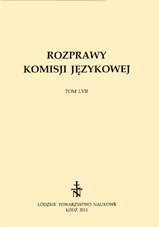
The influence of Georg Wenker’s german sentences on their Polish translations in the survey for the all-German dialectological atlas
Wpływ niemieckich zdań Georga Wenkera na ich polskie tłumaczenia w ankietach do ogólnoniemieckiego atlasu dialektologicznego
Keywords: Polish dialectology; Masurian dialects; Polish-German linguistic contacts
The subject of the article is sentences selected from 80 questionnaires in 3 districts of Eastern Masuria: Ełk, Olecko and Gołdap districts. They come from Georg Wenker’s 19th-century questionnaires collected for the German linguistic atlas. The analysed translations give a certain image of the influence of the erman language on Polish dialects located in that part of Prussia which was the farthest in the East of Prussia. The questionnaires show germanisms typical for those areas where Polish was spoken which were under German influence (e.g. overusing personal pronouns, using the preposition przed ‘before’ instead of dla ‘for’ – przed matkę ‘before mother’ instead of dla matki ‘for mother’), however a part of given syntactic and lexical equivalents is an example of an ad hoc translator’s creativeness which resulted from specific circumstances of translating the sentences prepared for the needs of a questionnaire (e.g. free translation of the noun Kinderei and verb durchlaufen). The questionnaire records from Eastern Masuria despite numerous features confirming influence of the German language (graphic, lexical, syntactic) prove quite good command of Polish, especially in its regional variety towards the end of the 80’s of 19th century. As we know, due to regulations of educational authorities of the Reich, the situation and status of the Polish language changed in the next years in favour of domination of German.
More...